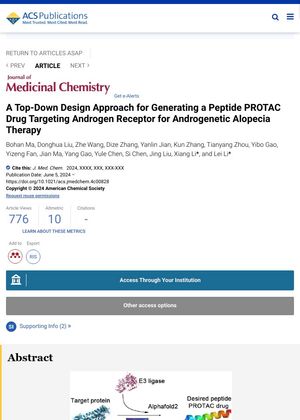A Top-Down Design Approach for Generating a Peptide PROTAC Drug Targeting Androgen Receptor for Androgenetic Alopecia Therapy
June 2024
in “
Journal of medicinal chemistry
”

TLDR A new AI-driven method shows promise for treating hair loss with a peptide-based drug.
The study presents a top-down design approach for creating a peptide PROTAC (proteolysis-targeting chimera) drug aimed at the androgen receptor to treat androgenetic alopecia. The research, conducted by a collaborative team from various institutions in China, focuses on developing a targeted therapy that degrades the androgen receptor, which is implicated in hair loss. The findings suggest that this novel peptide PROTAC could offer a promising therapeutic strategy for androgenetic alopecia by specifically targeting and degrading the androgen receptor, potentially leading to improved hair growth outcomes.


